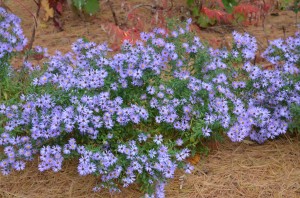New England aster (Symphyotrichum novae-angliae) is indigenous to a wide geographic area that encompasses moist prairies, meadows, valleys and stream banks in most Eastern and midwest states as far south to New Mexico. ‘Purple Dome’ is a very popular dwarf cultivar introduced by Dr. Richard Lighty, former director of Mt. Cuba Center in Greenville, Delaware. It grow 2 to 3 feet tall and 3 to 4 feet wide.
Purple Dome bears dark purple flowers that blanket its low growing shrubby form from mid-August thru early October. That’s 4-6 weeks of sustainable purple color. Blooms measure 1 ½ inches across with prominent bright yellow centers. The flowers are covered with nectar hungry bees and butterflies. Unlike most New England aster cultivars, Purple Dome requires no pinching or staking.
The lance-shaped dark green leaves are rough, hairy on the surface, and up to 4 inch in length. Bloom clusters make excellent bouquets. New England asters are very durable, long-lived, and tolerant of wet soils. Plants should best divided every 2-3 years in early spring.
New England asters grow in average well-drained soil in full sun although prefer moist, compost-rich planting sites. They have no serious insect or disease problems. Good air circulation around plants reduces potential foliar diseases, particularly mildews. Aster wilt may be an occasional problem, particularly if plants are grown in poorly-drained clay soils. Plants showing aster wilt symptoms should be quickly removed from the garden. Plants are rabbit resistant.
Purple Dome asters come highly recommended for inclusion in native plant areas, prairie restorations, and in rain gardens. Gardeners should add Purple Dome asters to low flower borders.


 Posted in
Posted in 
